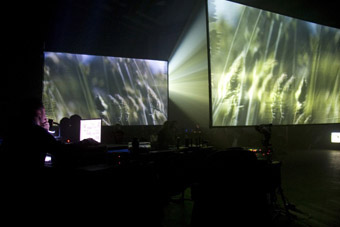dreams gentle and apocalyptic
tony osborne enters immersion:electrical empathy's ambient theatre

Immersion: Electrical Empathy
photo Alex Davies
Immersion: Electrical Empathy
IMMERSION:ELECTRICAL EMPATHY OFFERED A FASCINATING INSIGHT INTO THE AUDIO-VISUAL PRACTICE OF COLLABORATORS CONVENED BY VIDEO ARTIST SAM JAMES AND SOUND ARTIST GAIL PRIEST. USING MULTI-DIRECTIONAL STEREO, DUAL PROJECTION SCREENS AND A LITTLE SMOKE THEY ENSURED THAT ACCESS TO THE EXTREMITIES OF IMAGINATION WERE ACCESSIBLE BY PLACING THE AUDIENCE IN THE CULMINATING CORE OF THEIR WEEK-LONG RESIDENCY AT PERFORMANCE SPACE.
When I entered the Track 12 studio at CarriageWorks on the first night of the two-night program there were already shadowy figures moving through a slight haze and sweet ringing harmonics and pulsing tones wrapping around us in the low light. The effect was complete and immediate. The audience was enlisted into participation by virtue of their presence because there was no particular area designated for watching or listening, just chairs randomly placed as signs of encouragement to change our position. The movement this created served as a mysterious choreographic accompaniment to some very tasty machine tones ranging from sweet to apocalyptic.
Two large screens were suspended on diagonals and positioned to encapsulate the centre of the studio but leaving enough space for the audience to sit between them and observe in both directions. On screen was something that resembled blazing sunlight refracted through a pipe or narrow tunnel which provided background for two pulsing mites (they seemed to have tails) moving along symmetrical trajectories. The hint of a silhouette figure dancing across layers of images appeared and like so many of the projections to come it eluded fixity. Successive images impressed briefly then disappeared whilst others recurred and asserted thematic links. A spinal column laid itself across the screen only to break up into an oscilloscope effect; then its nature as a divide between split-screen water images was revealed. Flashes of light preempted images of lightning over a city night sky; multiple pulses drowned silence in hypnotic Afro-electronics then driven to submission by machine screams which in turn disintegrated into hums, whistles and the sound of metal objects ringing and clanging in discordant pleasure.
This disintegration was often realized in thematically linked sound and vision as video and sound artists located on opposite sides of the room engaged in collaborations of varying lengths and complexity. Some were live mixes of the other’s sound or simply responsive production of their own materials. One such coordination between Peter Newman and Scott Morrison resulted in digitized video images of three human figures breaking up into a series of smearing distortions that mixed into a mess of colour. Audio-visual material on Newman’s computer was being transferred for treatment by Morrison who manipulated it within his own processors before passing it on to the projectors.
Performative objects were not only provided by collaborative mixes and juxtapositions between music and image but also by the off-screen dramas being played out in the shadows. There was great theatrical effect in the audience seeking new vantage points and the intense attention of the operators in the glow of laptop screens as multiple hands hovered above sound and vision desks to implement elaborate mixing collaborations. Everything in the room was available to be observed. Everyone was elemental in the 360-degree setting and covert glances at the process underway were unnecessary. Observation was encouraged for there was no real ‘front’, even the screens could be viewed from many angles. Immersion was a kind of musical drama where the operators’ presence was integral to the ambient theatre they created.
When the video was designed around less recognizable objects, the imagery became more embedded in the sonic adventures and vice versa. The sounds throughout were so evocative, engaging and often disturbing that at some moments literal video objects interrupted my fabulist reveries. However, this was not the case in Nick Ritar’s slow reveal during a beautiful duet with Ai Yamamoto’s tuneful sample combinations in which a liquidating white screen became a shot of sky through a rain-filled windscreen. So, visual surprises could be welcome additions but mostly there was a surplus of imaginative material for me in the relentless drones, pulses and gentle screams that vibrated and emerged from the complex of circuitry. In an atmosphere where Peter Newman threatened subtle system overloads, Jason Sweeney incorporated human sounds into gentle rhythms and Gail Priest’s voices hung in endless reverb loops, the machine kept pulsing in the dark room. Sounds created imaginative worlds, images on-screen entered waking dreams and a shifting sonic depth of field immersed us into a multi-faceted sensual experience.
Immersion:Electrical Empathy, producer-collaborators Samuel James, Gail Priest, collaborators Cicada (Nick Ritar, Kirsten Bradley), Scott Morrison, Peter Newman, Jason Sweeney, Ai Yamamoto, Performance Space, CarriageWorks, Sydney, June 15, 16
RealTime issue #80 Aug-Sept 2007 pg. web






